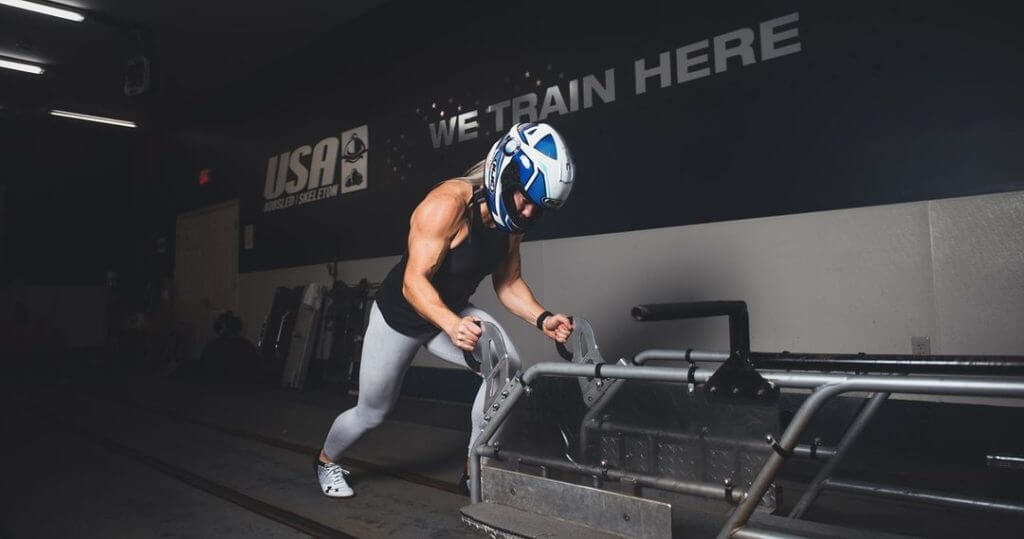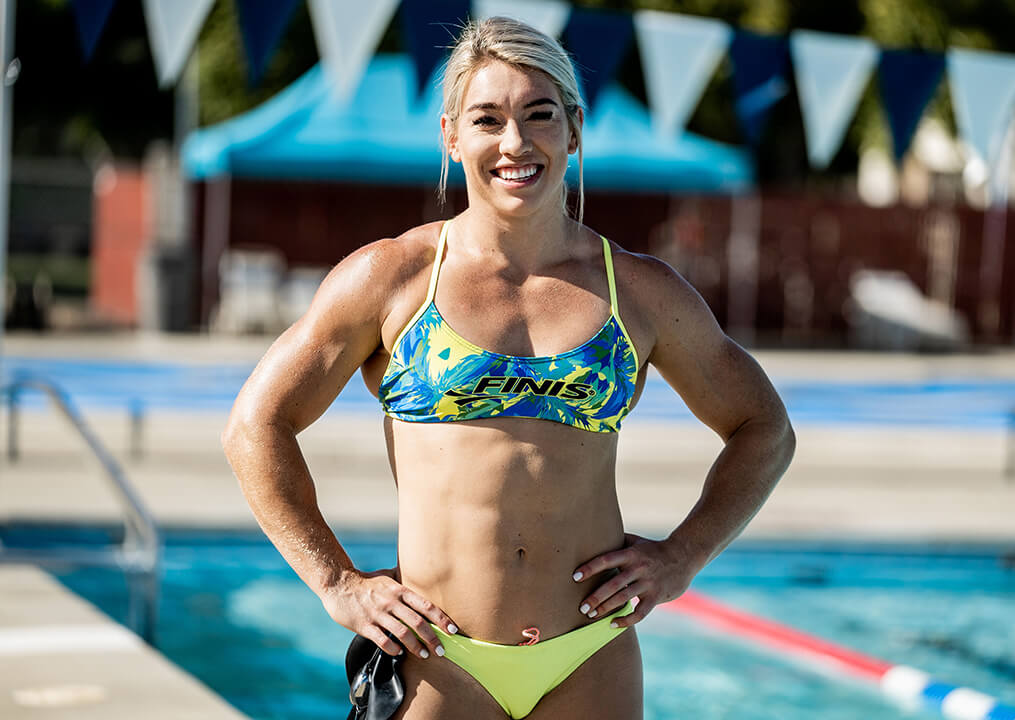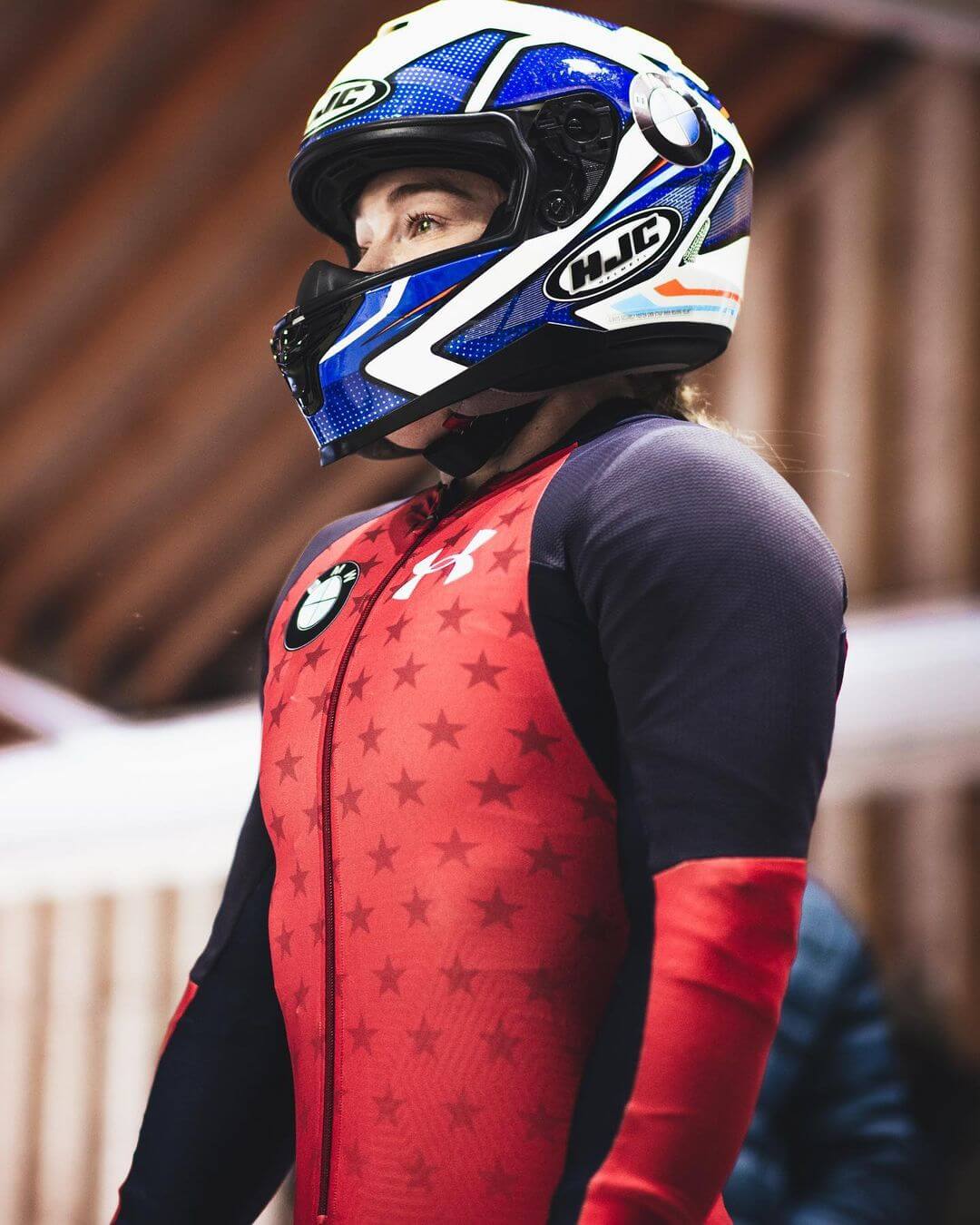Once an All-American Swimmer, Colleen Fotsch Pursuing Olympic Dream in Bobsled

Once an All-American Swimmer, Colleen Fotsch Pursuing Olympic Dream in Bobsled
Even by 2020’s unprecedented standards, Colleen Fotsch found herself somewhere she never would’ve expected last November.
Instead of home in balmy Arizona, Fotsch folded herself into a carbon fiber bobsled shell, hurtling down the track in Lake Placid at speeds in excess of 70 miles per hour, crammed into a sled behind Olympic gold medalist pilot Kaillie Humphries.
In the moment, as the adrenaline flooded her system and Fotsch pulled the brake lines as she learned days before that brakeman are required to do, all Fotsch could think about was when she’d be allowed to climb back to the start line and go again.
“Once I got in, I was like, OK, we’re in, this is awesome,” Fotsch told Swimming World last week. “And then you start going down the track and it was definitely an oh shit moment of like, oh my gosh, what is going on. It’s not like anything else I’ve ever experienced. It’s not like a roller coaster. It’s just so unique.”
Amidst the chaos of 2020, Fotsch discovered a unique opportunity. Now 31, she’s embarking on not a second but third chapter of her athletic career. At the University of California, she was an All-American and NCAA champion, competing at Olympic Trials in 2008. When her swimming career ended, she discovered a love for CrossFit, thriving in the strength-based workout routines and competing for the last six years.
Now, 13 years after she vied for an Olympic spot in the pool, she’s again trying to get to Beijing – this time on frozen H2O as a member of the U.S. Olympic bobsled team in 2022.
It’s a journey that even she finds difficult to comprehend at turns, one she would’ve never believed had you told her as an 18-year-old swimmer in 2008.
“She would’ve never believed me if I were to tell her about what was in store,” Fotsch said. “I think that girl would look at me now and not only just be really proud of the athletic accomplishments but proud of the person that she’s become. I think that’s what’s been one of the most amazing parts of my athletic journey through swimming and CrossFit and now bobsled, through sport I’ve just learned so much about myself and I think I’ve gained a lot of confidence through it. I’ve learned how to be really resilient.”
From Cal to CrossFit
Colleen Fotsch’s swimming memories gravitate toward racing. For all the time she now spends in the gym – or, during 2020, crafting workouts to while away hotel quarantines around bobsled trips – it’s racing that stands out most from swim career.

Colleen Fotsch; Photo Courtesy: FINIS
She created plenty of memories at Cal to look back on. After her freshman season at Notre Dame, the Palo Alto High grad transferred back home to Berkeley, where she was a key part of the Golden Bears’ national titles in 2011 and 2012. As a junior, Fotsch pulled off a daring individual double, scoring in the 100 butterfly (14th) and 100 backstroke (15th) in the same night session before joining the 200 medley relay to set all of the records – U.S. Open, Pac-12, school and pool marks. She also swam on the victorious 200 free relay that year.
In 2012, the same medley relay (Cindy Tran, Caitlin Leverenz, Fotsch and Liv Jensen) duplicated the feat, while Fotsch swam on a runner-up 200 free relay as Cal won another national title, its third in four years. She swam at Olympic Trials in 2008, finishing 101st in the 100 butterfly.
But like any self-respecting sprinter, when the racing stopped at season’s end, so did Fotsch’s enthusiasm for getting in the water without a clear goal to train for.
“I loved racing. It’s what I lived for,” she said. “I loved being on relays with my teammates and that was just the best feeling in the world. But I think I got to a point where once I was done and I was no longer training to race or win an NCAA championship, I was like, yeah I’m good, I don’t want to swim laps anymore. Unless it’s swimming around in a floaty, I’m going to stay away from the pool.”
Filling that gap of physical activity was a challenge. Fotsch returned to her alma mater as an intern then as a strength and conditioning coach, helping train some of her former teammates. She’s now pursuing a master’s degree in kinesiology online with Michigan State’s program. But there was a deficit in the place that competition held in her life for more than a decade.
For all that swimming taught her, she didn’t instantly love the athletic build she was left with, taking time to accept that. When it was driven toward a goal, that was easier to accept. But without that next meet to work toward, she was left unmoored in that area of her life.
Eventually in 2014, at what she has described as a low point emotionally, she followed friends to CrossFit. Her competitive fires were instantly reignited, from the obvious physical toll of the workout regimens to the psychological challenge of learning new motions and exercises. She’s participated in a number of regional and national CrossFit competitions, including ones with a swimming component. That inspired her to return to the water, both for recovery and training, which allowed her to “start to fall in love with getting back in the pool again,” still wearing her Cal cap.
The intricacies of CrossFit appealed to her meticulous nature, especially given the constantly changing program of events that forces athletes to stay sharp. Within the CrossFit world’s devoted fandom, she’s a bit of a celebrity. Fotsch operates a YouTube channel and an Instagram account with more than 330,000 followers, where she shares nutrition tips, workouts and other glimpses into her journey.
Her openness on social media reflects her journey to own the chiseled physique she has cultivated. Just last week, she posted about feeling insecure about her muscle tone as a swimmer and how she “failed to see and appreciate what my body and muscles were capable of doing and capable of.” The acceptance of her muscles, for what they are and for what they do, is a part of her journey to athletic achievement. And she carries that to the bobsled track.
“The main goal is performance,” Fotsch said. “My priority now is not what I look like but there’s a part of me that it’s just funny now, I don’t want my arms to be smaller. I want to make sure they’re really muscular because I’m proud of that and I’m proud of how hard I’ve worked for the body I have, not for how it looks but for what it’s allowed me to do and the fact that I wake up every morning and it gets me to the gym and I get to work toward one day maybe making an Olympic team. It’s cool to reflect back on that and how I perceive my body now vs. almost ten years ago.”
From CrossFit to the Chicanes
Each step in Colleen Fotsch’s journey positioned her to get on the radar of Humphries, one of the top pilots in American women’s bobsled. One of the sport’s challenges is the general absence of youth bobsled, in the way that other athletes grow up as swimmers or hockey players. That means constant recruitment of the athletes involved in the make-or-break seconds atop the hill, getting the sled from a dead stop to the velocity that powers the run.

Coleen Fotsch at national team camp in Lake Placid; Photo Courtesy: Instagram/@colleenfotsch
The most recognizable American women’s bobsledder is Lolo Jones, a sprinter and hurdler who ran at the 2008 Summer Olympics and pushed at the 2014 Winter Olympics. Like many of the push athletes, she brought athleticism forged in another sport that was applied via rigorous training in the finer points of the push. Of the national teamers, Nicole Brungardt was a volleyball player, as was Lauren Gibbs, who also ran track. Sylvia Hoffman competed in weightlifting among other sports. Elana Meyers Taylor played rugby for the national team and softball professionally. Olympic medalist Aja Evans was a shot putter. Lauryn Williams won silver in the 100-meter dash at the 2004 Summer Games and silver in bobsled at the 2014 Winter Games. Fotsch was joined by fellow CrossFitter Kelsey Kiel at camp this year.
To sustain itself, USA bobsled has to create a welcoming environment to its newcomers. Humphries knew that when she reached out to Fotsch, inviting her to come to California to train with her. And Fotsch, who had risen from the level of newbie to star in not one but two sports already, was not only familiar with the humility required to learn a new sport but willing to be the vulnerable again. Being in CrossFit, where she has to learn new things constantly even though the sports is ostensibly the same, also helped in that regard. (Among those events is pushing a weighted sled over turf, a little too on the nose of prep for bobsled hopefuls.)
“Honestly, I had no idea,” Fotsch said. “Obviously I had watched it in the Olympics, but I had no idea how athletes go into it, so it was really cool to learn about the combine and what team trials entails and what training for bobsledding looked like. … With bobsledding, it’s not like baseball or soccer or football; you can’t just go to your backyard and be like, I’m going to try this and see if I like this.”
Fotsch’s travels brought her first to California, to get to know Humphries and get an idea of the physical demands of pushing and what specific aspects of her strength she’d have to train. In November, she ventured to Lake Placid for her first runs down the ice, trying to take it all in.

Coleen Fotsch, right, with fellow CrossFitter turned brakeman Kelsey Kiel; Photo Courtesy: Instagram/@colleenfotsch
“The first time I went down, I had no idea where I was on the track, and now having taken more trips, it’s even more fun because you’re aware of where you are on the track and what curve you’re at and you know when the finish is,” she said. “Whereas my first trip, I just started counting in my head because I was like, ‘I know this is going to take around a minute to get down, so I’m just going to start counting.’”
Fotsch spent most of a month in Lake Placid, adapting to cold weather like someone with extended family in Wisconsin who lived in Illinois as a kid. Her performance at the scouting combined earned her a spot on the national team, which gives her an inside line in trying to compete next year.
While her physique has been completely transformed since her swimming days, there’s a part of the competitive mindset that remains with her.
“There’s a similar sense, being that I was a sprinter in swimming, that you’re going up to a block, you’re going all out,” she said. “Especially I kind of relate it to my relays, when I was doing a 50 free or a 50 fly, where you’re just going absolutely all out. My CrossFit workouts, there’s a lot more strategy and making sure you don’t blow up at the beginning. (Bobsledding) is not like that at all. You’re going for a few seconds, and you’ve got to go 100-plus percent.”
Fotsch will have to wait until the winter to get back on the ice, but there’s a push track set up at Lake Placid that replicates the crucial first seconds of the race for her. USA Bobsled will host push championships in July, and then testing and evaluation in the fall will determine how the federation approaches qualifying for Beijing and the world cup circuit. The women compete in the two-woman and the newly added monobob event. Fotsch would compete to be a brakeman for the two-woman. The U.S. sent two sleds to Pyeongchang in 2018 and three each to Sochi in 2014 and Vancouver in 2010. (That the women don’t compete in four-person bobsled like the men is a major battleground for gender equity; monobob is a concession to even up the men’s and women’s competitions at two events each in Beijing.)
Physically, it’s a long way from the pool. But as Fotsch realized while watching women’s NCAAs this year and reliving the competitive atmosphere she once occupied, there’s something very familiar to it all. In those moments when she’s locked in on the back of the sled, taking the final deep in breaths before unloading all her strength into the push for five lung-busting seconds, there’s something deep in her brain that feels the same as that 18-year-old waiting on the block for the start of a race.
“I’ve kind of reverted to mentally where I would go when I would go up to the block in swimming,” she said. “And what I love, too, is you’re going 100 percent, 110 percent, you’re not thinking about anything else.”



